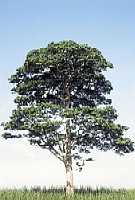| DESCRIPTION: A tree usually 30-40 m high, rarely to 50 m in the high forest. Trunk up to 2 m in diameter, bark usually smooth, greyish, 1-3 cm thick and red internally, in the forest branching 10-20 m above ground level, much lower in exposed sites, crown wide and open or dense. Root system fairly superficial with large roots often seen on the surface. Leaves alternate, compound, bifoliate. USES: Seed pods contain an edible powdery pulp and Jatoba bark tea is a quite popular drink. Seeds are used as fodder. Timber used for carpentry, general construction, wheels and cogs, dugouts, shipbuilding, posts, looms, cartwheels, rail ties and for cabinetwork, musical instruments, interior trim, plywood, turnery, and veneer. The trunk yields gum (it contains a medicinal oil - the resin - which burns like kerosene) and the bark tannin. The bark is common in local folk medicine as a cure-all, being especially useful for coughs. Used as shade tree and has occasionally used for coffee shade, also grown as an ornamental. GROWING PERIOD: Perennial. COMMON NAMES: Brazilian cherry. FURTHER INF.: It occupies a wide range of habitats. It has been reported in tropical dry forest, transition to pre-mountain moist forest, and tropical wet forest as well as subtropical moist forest. Tolerates not only poor fertility and waterlogging but also 4 months or more of drought, with temperatures typical of the wet lowland tropics, that is, diurnal temperature fluctuations are normally greater than seasonal temperature changes. The precipitation may be evenly distributed through the year or monsoonal. The tree develops best on ridges or slopes and high riverbanks. |
